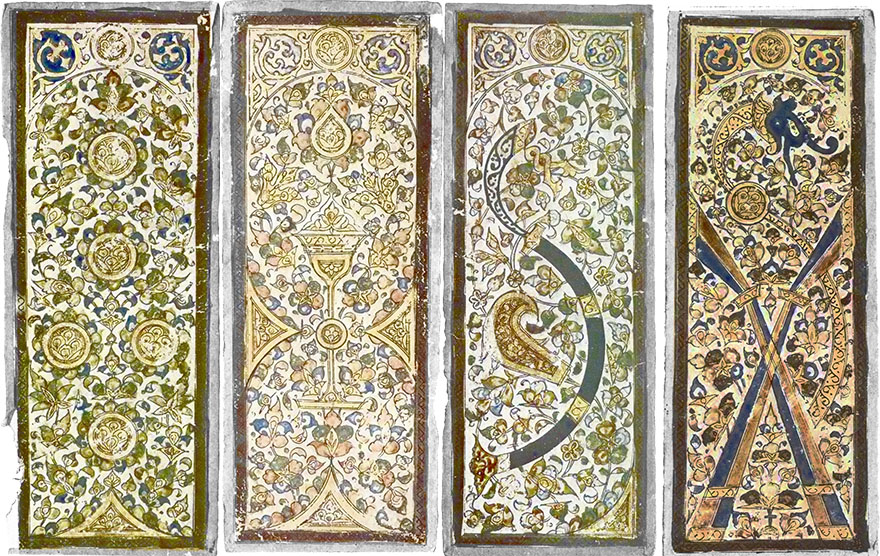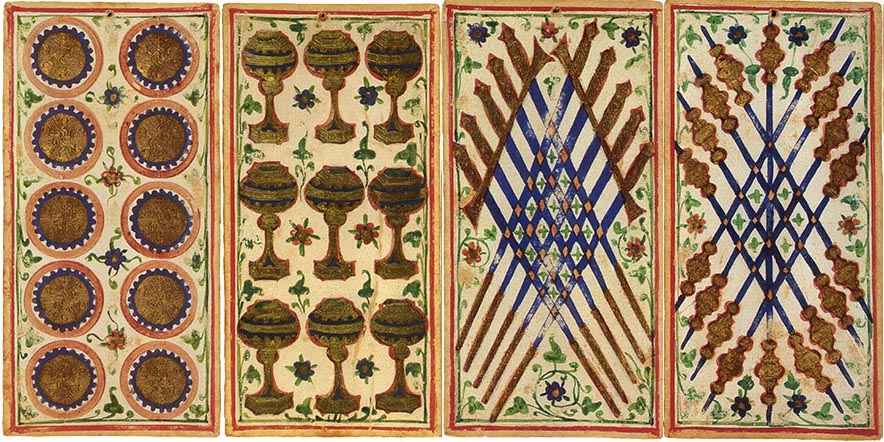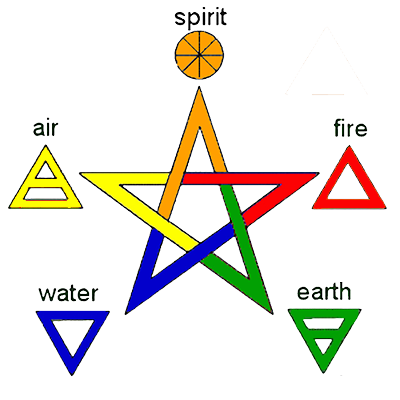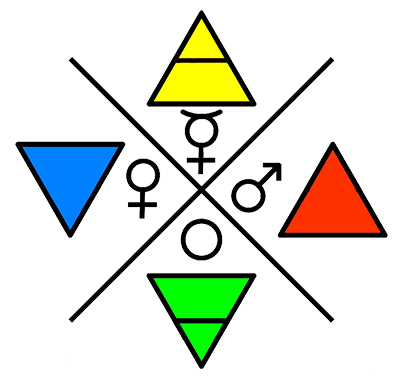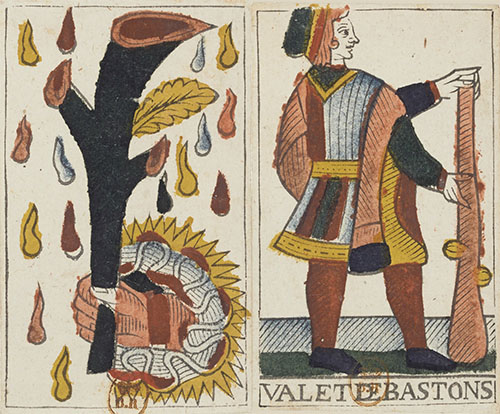THE TAROT WHEEL
THE SUIT SYMBOLS
In this section, we will deal with the origin of the suit symbols, and how they are related one to the other. When dealing with the individual suit symbols, we will deepen this knowledge a bit further. It is generally agreed upon that the Suit symbols in the Tarot find their origins in the Mamlûk cards, with just a slight modification for the polo sticks, not known in Western Europe. So let us start our exploration of the suit cards with its closest ancestors outside Europe, let us have a look at some Mamlûk cards.
We have here the Five of Coins, the Ace of Cups, the Ace of Swords and the Five of Polo sticks. The Islamic Art is theoretically purely figurative, it was not allowed to represent living creatures. But on these Mamlûk cards we can clearly distinguish leaves and flowers, and on the fourth card we even see that the fifth polo stick is portrayed as a snake-like animal with the head of a dragon. The Coins and Cups can easily be recognized, but the strangely curved sword and the polo sticks are with the dragon snake are less familiar. To state that the Italian card decks simply copied the Mamlûk symbols goes a bit too far. They were inspired by these cards, but why? The reason why these symbols were conserved might be that most of them were already part of our own cultural heritage. They could be easily associated with many well-known objects or concepts.
Coins are a symbol of power and wealth. Every strong leader taking care of his image had golden coins created full of references to himself. Even today, we still encounter on many coins the image of the head of state. The 18th Century and later occultists using the Tarot for their own purposes preferred to use a magic related symbol, the pentagram.
Cups. The quest for the Holy Grail was a very popular theme in medieval times. The Holy Grail is often represented as a chalice (although it is very unlikely that Jesus would have used a Chalice during the Last Supper). In the Holy Mass, the priest uses a Chalice, similar to the cups on the Tarot cards, to remember the last Supper and the act of Jesus transforming water in wine.
Swords. The curved swords of the Mamlûk deck are a bit strange, but on the other hand, the sword was the main weapon of a knight and as such it symbolized justice. There were many legendary swords, like the Joyeuse of Charlemagne, and Excalibur in the Arthur legends, to which people attributed enormous powers. For this reason, the symbol was easily adopted. The Italian standards cards adopted a curved sword, and the Spanish decks had a straight sword.
Polo sticks. They are not part of our cultural heritage, so they were transformed to some form closer to us. Arrows, a lance (that references to the legendary Spear of Destiny), the scepter of a King, wooden clubs, a sorcerer's wand, a living branch of a tree, the tree of life, many variations have been used on the theme. What seems to be central in most interpretations, is that in contrary to the other suit symbols, who are all metal objects, and in agreement with the symbol on the Mamlûk cards, batons are made of living wood. Wood as such not being an object used in occult practices, the ancient occultists preferred representing a sorcerer's wand. So 'Want' became the modern designation of this suit symbol. I will mainly use Batons on this site, in agreement with the Marseille Tarot.
So, the four suit symbols of the standard Italian card decks became Coins, Cups, Swords and Batons. As an example, I will show four numbered cards belonging to the Visconti Sforza deck, created probably for Bianca Maria Visconti somewhere between 1451 and 1453.
In the figure above we see the Ten of Coins, the Nine of Cups, the Ten of Swords and the Nine of Batons of the Visconti Sforza deck. These four symbols fitted very well the Northern Italian society in the 15th Century, and some people think that this is the reason why these symbols were so easily adopted. Comparing the suit symbols with Northern Italian Society at the end of the Middle Ages, we can make some very obvious correspondences. In Northern Italy emerged around the 12th Century, some big cities that struggled against the dominating power of the Holy Roman Empire. These cities were rather big, in the 13th Century Venice, Florence and Milan had each over one hundred thousand inhabitants. Other cities like Bologna, Verona and Genoa were not that big, but even they had largely over fifty thousand inhabitants and were difficult to control by centralized Feudal power. The independence of these cities was also advantaged (except for those situated in the Po valley) by the mountainous aspect of Italian landscape. So many City States emerged, centered around one of these cities :
Very Specific for Italy, was the occurrence of independent Republics, ruled by the citizens themselves. Thanks to trade and commerce, these cities became rich and powerful. The best examples are Venice and Genoa, that thanks to the marine trade became very wealthy. But also Florence became an independent City. It was ruled by the mighty 'Di Medici' family, who were bankers from origin. Thanks to the banking business, Florence became wealthy. Many modern account practices found their origin in Florence. These wealthy merchants and bankers were easily symbolized by the suit of Coins.
Not all Cities could rise to independence. In the Center of Italy, the Roman Catholic Church had conquered a vast territory that we call the Papal States. And even if big cities like Bologna and Ferrara were ruled by mighty families, acting almost as feudal lords, these families stayed dependent on the Pope. As an example, it was the Pope who changed the title of Borso d'Este from Lord of Ferrara to Duke of Ferrara. This was important because the title of Duke was hereditary and the title of Lord wasn't. With the quest for the Holy Grail associated to the Cups, this suit symbol was an evident symbol for the clergy ruling the Papal States.
In the Northern part of Italy, many City States rested, at least in name, dependent on the Holy Roman Empire. The best example is Milan. In Milan was kept the Iron Crown of Lombardy, symbol of power for the Kings of Italy. Before becoming Emperor, the King of the Germans, the pretender to the throne had to be crowned King of Italy in Milan. Only the so crowned King of Italy could obtain the title of Emperor by benediction of the Pope in Rome. In 1431 Sigismund passed to Milan, to be crowned King of Italy before being crowned Emperor in 1433 in Rome. Although well aware of the power of the future emperor, Filippo Maria Visconti refused to meet Sigismund during his visit. The father of Sigismund was the Emperor Charles IV, emperor from 1346 to 1378. His older brother Wencelas never got the title of Emperor, although he was the main pretender. Wencelas was often drunk and spoiled a lot of money. The father of Filippo Maria, Gian Galeazzo Visconti, took advantage of this and bought in 1395 the title of Duke from the almost bankrupt King of the Germans. The Dukes had a mighty army, and the Swords could easily be associated with the mighty nobility ruling over vast territories.
The three suit symbols corresponding to metal objects Coins, Cups and Swords associated in this way with the different types of ruling classes, one wooden object, the Batons was left. This symbol was not associated with a ruling class, instead it could symbolize the Working Class, the majority of the inhabitants of a state, poor people who did not have their own land or property and who had to work for the rich classes.
For us, the association between the suit symbols and the different classes in Northern Italian society is only interesting from a historical point of view. Many more associations can be made and what is fascinating for us is how they act as a model for the Universe, where the trump cards represent the spiritual world and the human life cycle, and the four other suits the physical world and human society.
Through the ages, the Physical World has been symbolized by the four elements; Earth, Water, Air and Fire. This division in a physical world and a spiritual world is visualized in the figure here at right, pictured as a pentagram, where we find the four elements representing the physical world with on top of them the Human Soul, representing the spiritual world. The four elements are represented by the suit cards and the fifth element, the Human Soul, is represented by the trump cards. So, the next question is, how are the suit cards associated with the individual elements?
Before answering this question, let us first dive a little deeper in the elements, and try to understand what they are really representing.
Now we know the elements a little better, we can start making associations. In the figure here at left, we can see the elements, associated with colors and with the inner planets. Earth is naturally associated with the planet Earth and its color is green, like the vegetation that is covering it. Fire, equivalent of energy and the driving force behind life, is associated with the planet Mars. Its color is red like the flames of Fire or like blood that is circulating in our body. Water is associated to the planet Venus, and its color is blue, the color of the water covering the major part of our planet. Air is associated with the planet Mercury, and its color is yellow, the color of intellect. We have two masculine dynamic Gods, Mars and Mercury, their triangles are pointing upwards and their colors are aggressive, red and yellow. Below them, we have two Goddesses, Venus and Gaia (Mother Earth). They are receptive, and their triangle is open to the top, their colors are the peaceful colors of our planet, blue and green.
However, this is not very interesting for us, we want to know how the suit symbols can be associated with the elements. This is not as evident as we might think, and many card makers associated the suit symbols and the elements differently:
Cups. This is the only suit, as far as I know, that every card maker agrees upon. Cups are a recipient for liquids, and as such they are associated with water.
Batons. Most card makers associate them with fire for several reasons. When fire is seen as a destructive type of energy, Batons represent firewood. Also, when we see Fire as a constructive force, the energy of Life, the tree of life, wooden Batons, that are considered being a living material, are easily associated with this element. Other card makers associate the Batons with the vegetation covering the Earth, so for them the right association is with the element Earth. And still, other card makers represent the Batons as Arrows flying through the Air. For them, the correct association you have to make is between Batons and Air.
Swords. There are two mainstream interpretations, those who consider the Swords as a symbol for the Sword of Justice, and those who consider the Swords as a symbol for the Sword of War. Symbolizing the Sword of Justice, the Swords are associated with the intellect and with Air. However, when considered as the Sword of War, the Swords are associated with Fire and destruction.
Coins. Usually Coins are associated with Earth, if you have enough money you can move mountains. Others state that money is forged in fire and responsible for the death of many people, so you have to associate it with the element Fire.
In Medieval times, when we were talking about the elements, we were talking about the building blocks of nature. These building blocks of nature could be dead material or a living creature. Everything in nature was made up of one or more of the elements, nothing else was necessary to explain the composition of an object. Earth represents solid objects like a stone, water represents liquid objects like the sea, air represents gaseous objects like our atmosphere and fire represents concepts that were more difficult to get hold on, like fire and lightning. An object could consist of a single element, like a piece of rock, or it could consist of several elements, like mud, that is a mixture of solid and liquid materials. Living creatures combined all elements within their body. The skeletal parts of a body are solid, blood is liquid, and all living creatures are in one way or another respiring. The element fire represents the Spirit of Life itself. Only humans posses the fifth element, the Human Soul. There is a clear hierarchy in the elements. When a living creature dies, the element fire, representing life itself, disappears first. When the element fire disappears, the creature stops respiring, so the element air disappears from the body. The body will slowly rot away or dry out, the element water disappears, and only the element earth will stay behind. In the Bible, this is written in the following way :
all are of the dust, and all turn to dust again (Ecclesiastes 3:20)
Today we know that the four elements are, in fact, different energy states of the same basic material. Take for example water. In its lowest energy state, at the coldest temperatures, water is solid, and we call it ice. If we heat ice, it will melt and become water. When we are heating water, it will evaporate and become vapor. We can see vapor, for example, as clouds in the sky. These changes are reversible; clouds can condense and form rain drops. Water can freeze and become ice. So in all the three energy states, the internal structure does not change. But if we heat up a gas until extremely high temperatures, the element disintegrates, liberating pure energy. It will never be the same element again. This disintegration process is visible in nature as fire. Ash can never be turned back again in wood. And the other way around, when life disappears out of a living creature, it will never become a living creature again. The passage between the third and the fourth element is an irreversible process. The process of dying is an unstoppable process of energy fading away, from the highest energy level (Life) via intermediate levels (Air and Water) back again to the lowest level (Earth).
Whatever deck you are using, try to make the associations as intended by the card maker. On the Tarot of Marseille and on the Trionfi decks of the Estensi family, Coins were associated to Earth, Cups to Water, Swords to Air and Batons to Fire. Filippo Maria Visconti reversed the associations of Swords and Batons. Paul Huson, in his Dame Fortune's Wheel Tarot, switches Coins and Batons. Personally, I prefer the constructive associations expressed in the Estensi decks and in the Tarot of Marseille.
Using these associations in comparison with modern suit cards, red suits are representing the receptive suits and black suits the dynamic ones. So, hearts corresponds to cups, diamonds to coins, clover leaves to batons and spades to swords. But again, opinions differ from one author to another. The best solution is to follow your own intuition and to choose decks using apparently those associations, that seems most naturally to you.
As an example we present in the figure above the Ace and the Knave of Bastons of the Tarot of Marseille made by Jean Noblet. From these illustrations it is clear that in the Tarot of Marseille, the batons have nothing to do with fire wood, there are leaves and buds on the Batons, it is living wood. Here the element Fire must be considered as the energy of Life.
To summarize, the suits, when related to the elements, are, when ordered from the lowest energy level to the highest, Coins (Earth - Gaia, the Goddess Earth, solid materials), Cups (Water - Venus, the goddess of Love, liquid materials), Swords (Air - Mercury, the messenger God, gaseous materials) and Batons (Fire - Mars, the God of War, pure energy). The trumps are related to the fifth element and represent the Human Soul. Coins and Cups are receptive female symbols and Swords and Batons are dynamic male symbols. But these are not the only associations, we can make other ones, which are more useful for meditation and card reading. We come back to the other associations when we reach the pages dealing with the individual suit symbols.
